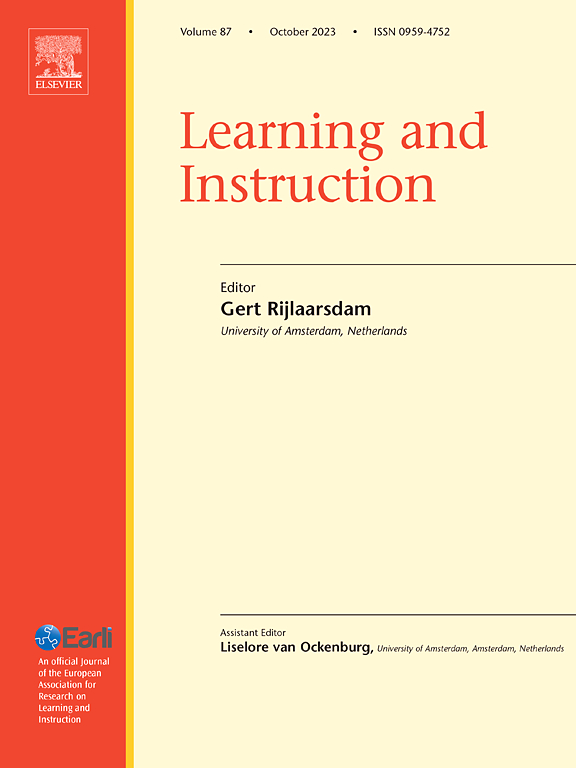创造力的前因:大学生团队互动的统计语篇分析
IF 4.9
1区 教育学
Q1 EDUCATION & EDUCATIONAL RESEARCH
引用次数: 0
摘要
许多社会问题(气候危机、战争等)太复杂,个人无法解决,需要团队创造力。因此,许多大学教师帮助学生合作来培养他们的创造力。由于学者们尚未确定团队的先行谈话过程有助于或阻碍创造性想法的出现,我们研究了谈话类型(例如,同意,不同意,邀请问题)及其序列(例如,连续的邀请问题)如何影响原创,可行或创造性想法的可能性。方法我们调查了4个三合会的12名学生的4047个话语,这些学生在课堂上解决了一个开放式的生活方式问题。结果统计语篇分析表明,带邀请性问题或思考标记的话语更容易产生原创性、可行性和创造性的想法。相比之下,连续的邀请性问题、不相关的谈话或过程性谈话不太可能产生原创的、可行的和创造性的想法。综上所述,这些发现表明教师应该在团队头脑风暴中鼓励邀请性问题,监督连续的邀请性问题,给学生思考的时间和空间,并阻止任务外的讨论。本文章由计算机程序翻译,如有差异,请以英文原文为准。
Antecedents of creativity: Statistical discourse analysis of university student teams' interactions
Background
Many societal problems (climate crisis, war, etc.) are too complex for individuals to solve and require team creativity. Therefore, many university teachers help their students collaborate to cultivate their creativity. As scholars have not yet determined teams' antecedent talk processes that aid or hinder the emergence of creative ideas, we examined how types of talk (e.g., agreement, disagreement, invitational question) and their sequences (e.g., consecutive invitational questions) affect the likelihood of ideas that are original, feasible, or creative.
Methods
We examined 4047 utterances by 12 students in 4 triads working on an open-ended, lifestyle problem in their classroom.
Results
Statistical discourse analysis showed that utterances with an invitational question or thinking marker were more likely to yield original, feasible, and creative ideas. By contrast, consecutive invitational questions, irrelevant talk, or process talk were less likely to yield original, feasible, and creative ideas.
Conclusions
Together, these findings imply that teachers should encourage invitational questions within team brainstorms, monitor for consecutive invitational questions, give students time and space for contemplation, and discourage off-task discussions.
求助全文
通过发布文献求助,成功后即可免费获取论文全文。
去求助
来源期刊

Learning and Instruction
Multiple-
CiteScore
11.30
自引率
4.80%
发文量
109
期刊介绍:
As an international, multi-disciplinary, peer-refereed journal, Learning and Instruction provides a platform for the publication of the most advanced scientific research in the areas of learning, development, instruction and teaching. The journal welcomes original empirical investigations. The papers may represent a variety of theoretical perspectives and different methodological approaches. They may refer to any age level, from infants to adults and to a diversity of learning and instructional settings, from laboratory experiments to field studies. The major criteria in the review and the selection process concern the significance of the contribution to the area of learning and instruction, and the rigor of the study.
 求助内容:
求助内容: 应助结果提醒方式:
应助结果提醒方式:


